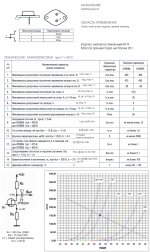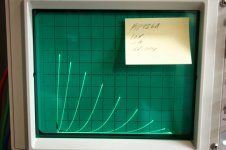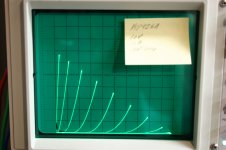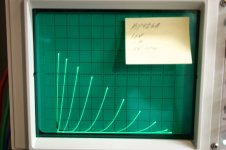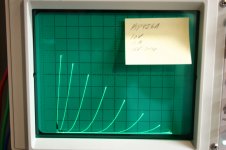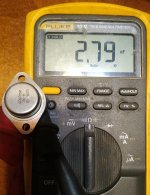I recently purchased and received parts from a Russian seller of KP926B. The curve tracer says that they are all genuine SITs.
The reason I am interested in these parts is for the 400V Vce. They may serve well for an electrostatic headphone amplifier.
They devices are widely different from each other. You would need a large population to obtain a matched quad. Even one matched pair will require quite a few devices.
The reason I am interested in these parts is for the 400V Vce. They may serve well for an electrostatic headphone amplifier.
They devices are widely different from each other. You would need a large population to obtain a matched quad. Even one matched pair will require quite a few devices.
Sorry, can't help it. I can read this DS.
Translation.
Just FYI No mu given. Rds is for BJT mode with rather large gate current.
Translation.
Just FYI No mu given. Rds is for BJT mode with rather large gate current.
Attachments
Last edited:
Alexberg thanks for the work pity they couldn't have listed the mu though. I could calculate it from the curves but I am getting rather lazy in my old age.
They report transconductance at 20V 4A on their datasheet. Mu would be the transconductance times the drain resistance. However, this figure is of dubious merit since, as you observed, there is some variation from part to part and ultimately you would want to figure the mu in the area of interest for your particular sample. 🙂
Attachments
N (BACKWARDS N) = I = ISTOK = SOURCE = PIN 1
C = S = STOK = DRAIN = PIN 2
3 = Z = ZATVOR = GATE = PIN 3
🙂
C = S = STOK = DRAIN = PIN 2
3 = Z = ZATVOR = GATE = PIN 3
🙂
Look, I used to work with those back then.
With all do respect you can't use RdsON in DS cause it's measured with sic! gate current.
So one need to measure resistance at operating point by varying drain voltage a bit, for instance.
Cheers!
With all do respect you can't use RdsON in DS cause it's measured with sic! gate current.
So one need to measure resistance at operating point by varying drain voltage a bit, for instance.
Cheers!
I spoted those too and found the data sheet on them but it's in Rusian. Did you measure the MU or can you read this data sheet ? And what seller did you get them from.
Hello Woody
I did not extract Mu. Below is a definition of Mu that I found with a Google search. It is in regard to a vacuum tube.
mu = dVp / dVg
This is the AC voltage gain for small signals, being the AC voltage in the plate divided by the AC
voltage on the grid, with the plate current held constant.
At the moment, I am not sure how to set up the curve tracer to extract Mu in a continuous fashion the way that Vds-Id and Vgs-Id curves are traced. Any suggestions are welcomed.
As I mentioned, you want to measure in the area of interest.
This may provide a little additional information:
YouTube
🙂
Ok. Got it. You use two different Vds values, run two different Vgs-Id curves, find the two different Vgs values where your intended constant Id happens.
So, Mr. Woody, if you want Mu for the KP926, you have to specify what what constant Id you are interested in and what Vds you are interested in.
My guess would be that we want Mu for a First Watt-ish implementation.
Watch the Pd. They're only 50W parts, and you'll only want to run them at a quarter of that, maybe half if you like to live dangerously. 🙂
Watch the Pd. They're only 50W parts, and you'll only want to run them at a quarter of that, maybe half if you like to live dangerously. 🙂
That would make a single part not suitable for a FirstWatt class-A design.
For me, the attraction is high voltage and low current as a Stax headphone driver.
I have a pair of Stax Gamma that I would like to use the KP926 for.
Assuming some people are not EE.I don't see where anyone mentioned doing that. Were you talking to me? 🙂
If one vary Vds with Vgs fixed then rp=deltaVds/deltaId, where rp is drain resistance (plate for a triode). Is not it?
I would like to know the KP626A input capacitance,from the Russian datasheet,it seems like show 1150pf,but I am not sure
- Home
- Amplifiers
- Pass Labs
- KP926B on FleaBay
